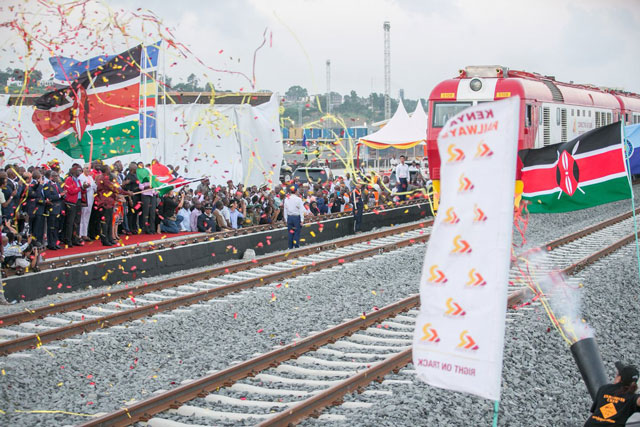
Nairobi, Kenya | AFP | The timing was perfect. Two months before Kenya’s August 8 vote, President Uhuru Kenyatta inaugurated the nation’s biggest infrastructure project: a railway connecting the capital Nairobi and the port of Mombasa.
With pomp and ceremony Kenyatta touted the railway as proof of his campaign promises on the economy, yet at the same time the price of maize flour, a Kenyan staple, was rising fast, stoking anger, especially among the poorest.
Rising food prices constitute a crisis on the eve of a high-stakes election in which Kenyatta, and his economic record, go head to head with longtime opposition leader Raila Odinga.
“On the one hand, there’s the symbol of Kenya which continues developing — even though it means an increased debt — and remains the most dynamic economy in East Africa,” said Francis Mwangi, an analyst at Standard Investment Bank. “On the other hand, there’s the Kenya which hardly benefits from the effects of economic growth.”
Kenyatta has put the economy at the heart of his campaign. Thanks largely to increasing household consumption and public investment Kenya has seen growth of more than five percent a year since his election in 2013.
But analysts say there is more — and less — to Kenya’s economy than meets the eye.
The country’s debt is rising, corruption is endemic and economic growth has not benefited the country’s poor, they say.
– Not your average African economy –
As in many other African countries, agriculture is the dominant activity, but Kenya’s economy is atypical in other ways. It has relatively few natural resources, but the country’s stability, economic dynamism and well-developed service industry stand out.
Kenyatta has presided over a slew of infrastructure projects, including airports, roads, bridges, the start of a new port in the town of Lamu and wind and geothermal energy plants to boost electricity production.
Ethiopia’s larger, cheaper workforce means it recently overtook Kenya as the region’s biggest economy, but analysts say the world’s largest tea exporter remains East Africa’s most dynamic market thanks to its skilled workers, fast internet and entrepreneurial mindset.
Terror warnings and attacks, including the 2013 jihadist assault on Nairobi’s Westgate mall, scared off tourists for a while, but the country’s International Monetary Fund representative Armando Morales said the country has since bounced back.
“Despite that, the GDP grew quite well, and conditions for business have improved,” he said.
But not all of Kenya’s progress can be credited to Kenyatta. His term in office coincided with low oil prices and his economic policies broadly match those of his predecessor who kickstarted some of the more eye-catching infrastructure projects Kenyatta takes credit for.
Devolution has given counties more money and power, which has led to improvements in health infrastructure and the construction of wells and dams, said Winnie Mitulah, a development specialist at the University of Nairobi.
But government spending on new public works has caused Kenya’s debt to balloon, increasing during Kenyatta’s term to over 50 percent of GDP, much of it owed to Chinese lenders who negotiated advantageous terms.
“I think Kenya had to make those investments,” said Aly-Khan Satchu, a Kenyan analyst. “But now, they need to reap the benefits of those investments, but they also need to space the next investments carefully.”
– Widespread corruption –
Observers say it’s difficult to talk about Kenyatta’s economic record without including his poor performance in battling corruption.
Graft is widespread in Kenya, and while Satchu said it is difficult to tell just how deep it runs, he believes it represents a major drain on the economy.
“Look where Kenya is now, and imagine where it could be without all that money disappearing through corruption,” he said.
Perhaps the biggest criticism levelled at Kenyatta is that despite the growth, Kenya’s poor haven’t seen much improvement in their daily lives, Mwangi said.
That’s in part because Kenya lacks a strong manufacturing base able to provide mass employment.
A drought since late 2016 has reduced agricultural production, hitting the poorest hardest. Compounding the problem, producers speculated and the government was slow to respond.
As a result, a two kilogramme bag of the staple maize flour — known as ‘unga’ and used to make the hugely popular ‘ugali’ — rose to as much as 180 shillings ($1.70; 1.80 euros), up by almost 50 percent in a year.
With elections less than a week away, several opinion polls have identified food prices as the top issue among Kenyans.
“In Kenya, we have a saying: ‘you can’t eat GDP'”, said Satchu.
 The Independent Uganda: You get the Truth we Pay the Price
The Independent Uganda: You get the Truth we Pay the Price





